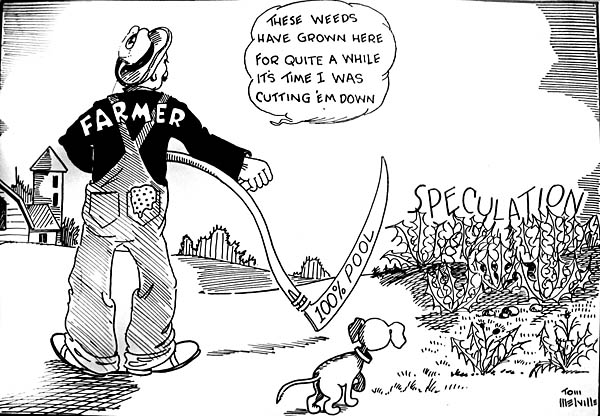 (January 13, 2016) Over the past year Canadians cut off a number of things, most notable of which were neo-conservative governments in Ottawa and Alberta. For some the shell shock has hardly worn off.
(January 13, 2016) Over the past year Canadians cut off a number of things, most notable of which were neo-conservative governments in Ottawa and Alberta. For some the shell shock has hardly worn off.
2015 also marks four years since the Harper administration created mighty and lasting grudges on the prairies by killing the Canadian Wheat Board in an undemocratic and legally dubious process. At this distance a number of things have become painfully clear:
– The farmers’ share of the international grain price is down by at least half and likely more. Agricultural economist Dr. Richard Gray of the University of Saskatchewan has published several papers demonstrating that farmers ought to have at least 50% more dollars from their grain sales than the middlemen of the private trade are giving them.
– The annual audits of rail performance carried out by the Canadian Transportation Agency in the 2013/14 and 2014/15 crop years show the claim of the grain trade that poor railway performance is causing high basis levels is false. In fact the low prices farmers see are really the result of excess profits taken by the grain trade.
– Prairie farmers have gone from being major exporters of grain with direct relations to end-use customers through the Wheat Board to being held captive in a domestic market by just a few giant grain handling companies and their agents.
– Canadian farm debt has now topped $90 billion dollars. Many economists thought when we broke the $50 billion mark that level was unsustainable. Anyone looking at the amount of unsold machinery sitting on dealer’s lots across western Canada or reading of the further consolidation of farm equipment dealers and manufacturers knows something is broken.
– It is not possible to remove more than half of the wheat and barley revenue from western Canadian farmers, double the farm debt level, and have the west remain as prosperous as it has been.
– The real grain price situation for farmers got substantially worse in 2015. Grain is priced in US dollars and because the Canadian dollar has lost 30% of its value the domestic grain price for western farmers should have increased accordingly – if there was really such a thing as a market – but it did not.
Instead the price for number one wheat in Manitoba is effectively $4 US a bushel, a price not seen for decades, and if you adjust for inflation, it is a price closer to great depression levels than ever before.
Free market farmers touted modest Canadian price increases as proof things got better without the CWB. The numbers show they are living in a fool’s paradise. As Dr. Gray observed of 2014/15:
“Yes, (western) farmers had a good year, but that doesn’t take away from the fact they could’ve been several billion dollars better off.”
Certainly the results of planting rather than cutting off ideology are still plain to see in the Alberta Check-off commissions. At last report the Alberta Wheat Commission was planning to investigate what grain was actually selling for at port. Something they announced with much fanfare last year as well.
As said here before, the actual sales price the private trade gets from end-use customers are amongst the most closely guarded secrets of the grain trade. These sales prices have only a casual relationship to port prices, and reports of port prices are unreliable at best. I can only assume the worthies on the Alberta Wheat Commission have been watching too many James Bond movies and plan to skulk around grain company headquarters listening at keyholes.
So in many ways 2015 was a recap of 2014 with the usual suspects’ ignoring the loss of money to prairie farmers and the ominous growth of farm debt. We can only hope 2016 sees the continued cutting off of the ideology planted by the Harper regime over the past nine years.

